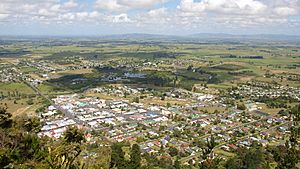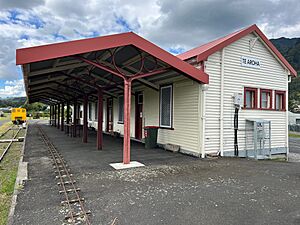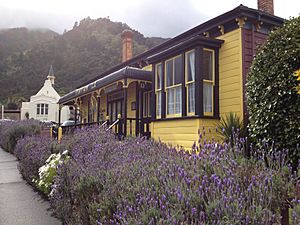Te Aroha facts for kids
Quick facts for kids
Te Aroha
|
|
|---|---|
|
Minor urban area
|
|

Cadman Bathhouse in Te Aroha Domain
|
|
| Country | New Zealand |
| Region | Waikato |
| Territorial authority | Matamata-Piako District |
| Ward | Te Aroha |
| Electorates |
|
| Area | |
| • Total | 10.96 km2 (4.23 sq mi) |
| Population
(June 2023)
|
|
| • Total | 4,670 |
| • Density | 426.1/km2 (1,103.6/sq mi) |
| Postcode(s) |
3320
|
Te Aroha (which means "love flowing inland" in Māori) is a small town in the Waikato region of New Zealand. It is home to about 4,554 people, based on the 2018 census. The town is located about 53 km (33 mi) northeast of Hamilton and 50 km (31 mi) south of Thames. Te Aroha sits right at the base of Mount Te Aroha, which is 952 metres (3,123 ft) tall and the highest point in the Kaimai Range.
Contents
Discovering Te Aroha's Past
The name Te Aroha comes from the Māori name for the mountain. The full Māori name for the town is Te Aroha-a-uta. This means "love flowing inland." An old Tainui story tells us that Rakataura, a wise leader from the Tainui canoe, named the area. He felt great love for his wife, Kahukeke, who passed away during their journey south.
European Settlement and Gold Rush
European settlers first arrived in the late 1870s. The town quickly grew in the 1880s because of a gold rush. People came hoping to find gold! A special spa was also opened in 1883, offering relaxing mineral baths.
Te Aroha used to have its own local government called the Te Aroha Borough Council, which started in 1898. Now, the Matamata-Piako District Council manages the area.
Famous Fizzy Drink and Natural Disasters
Did you know a fizzy drink called "Te Aroha and Lemon" was first made here in 1888? It stopped being made in the 1960s but started again in 2022!
Te Aroha has also faced some challenges. On February 17, 1985, a big flash flood hit the town. Boulders, mud, and trees were washed through the streets. Many homes and shops were damaged, and sadly, three people lost their lives. More recently, on January 4, 2022, a magnitude 5.1 earthquake shook the area.
Bridges and Railways in Te Aroha
The Coulter Bridge, which crosses the Waihou River on State Highway 26, was rebuilt in 1928. The railway bridge, first built in 1885, was later rebuilt in 1912. Today, it is used as a footbridge for walking.
The railway line reached Te Aroha in 1885, and the train station opened on March 1, 1886. Te Aroha was the end of the line for a while, until the railway was extended to Paeroa in 1895. Both the Te Aroha station and a smaller station called Herriesville closed to passengers in 1967 and to freight in 1986.
| Preceding station | Following station | |||
|---|---|---|---|---|
| Waihou Line closed, station closed 4.8 km (3.0 mi) |
Thames Branch New Zealand Railways Department |
Tui Pa Line closed, station closed 2.49 km (1.55 mi) |
||
People of Te Aroha
Te Aroha covers about 10.96 km2 (4.23 sq mi). In 2018, the town had an estimated population of about 4,554 people. This means there are about 426 people living in each square kilometer.
| Historical population | ||
|---|---|---|
| Year | Pop. | ±% p.a. |
| 2006 | 3,810 | — |
| 2013 | 4,005 | +0.72% |
| 2018 | 4,554 | +2.60% |
The population of Te Aroha has been growing. In 2018, there were 4,554 people living here, which was 549 more than in 2013. About 18.6% of the people were under 15 years old.
Most people in Te Aroha are of European background (84.8%). About 17.7% are Māori, and smaller numbers are from Pacific Islands or Asia. About 17.1% of the people were born outside New Zealand.
When asked about their beliefs, almost half (48.6%) said they had no religion. Many others (37.2%) were Christian.
Te Aroha's Landscape
The Waihou River flows right through Te Aroha. To the east, you can see the Kaimai Range and the tall Mount Te Aroha. To the north, there are flat, swampy areas known as the Hauraki Plains.
Hot Springs and Geysers
Te Aroha is famous for its thermal and mineral springs, which are found close to the town center. Māori people used these springs for many years before European settlers discovered them in the 1870s. The water from the hot springs is very warm, between 75°C and 85°C, but it is cooled down before people can soak in the pools.
Te Aroha is also home to a special hot soda-water geyser called the Mokena Hou Geyser. It's the only one of its kind in the Southern Hemisphere!
Te Aroha's Economy
Te Aroha is in the middle of a big dairy farming area. This means much of the town's work involves supporting the dairy farms and their communities.
Tourism is also becoming more important in Te Aroha. The mineral baths and geyser are very popular with both visitors and local people.
In the past, mining was a big part of the area's economy. You can still see old miners' cottages around town.
Fun Things to Do in Te Aroha
Te Aroha is home to the Mokena Hou Geyser, which is the only natural soda water geyser in the Southern Hemisphere. You can find this amazing geyser and the historic Edwardian spa complex in the Te Aroha Domain.
The Hauraki Rail Trail is a popular cycling and walking path that connects Te Aroha to other towns like Paeroa, Waihi, Matamata, and Thames. It's a great way to explore the area!
Exciting Events in Te Aroha
- Rugby Match: The Waihou and Te Aroha Cobras rugby teams play an annual game for the Dr Dunn memorial trophy. It's a big day for the town!
- A Day in the Domain: This fun event started in 1977. It brings together artists, performers, food stalls, and games for a great day out for everyone.
- King and Queen of the Mountain: Since the 1950s, people have raced to be the first man or woman to run up Mount Te Aroha and back down. Some have done it in under an hour!
- Te Aroha AP & H Show: This show has been running since the 1890s. It features farm animals, horse riding, and classic country fair activities like gumboot throwing.
- Te Aroha Cruise In: This car event started in 2008 and brings many cool cars to town.
Schools in Te Aroha
Te Aroha has several schools for students:
- Te Aroha College: This is the town's high school.
- Te Aroha Primary School: A primary school for younger students.
- Stanley Avenue School: Another primary school in the town.
- St Joseph's Catholic School: A Catholic primary school.
All these schools welcome both boys and girls.
Famous People from Te Aroha
Many well-known people have connections to Te Aroha, including:
- Peter Snell: An Olympic Gold Medalist.
- Don Clarke, Kevin 'Herb' Schuler, Carl Hoeft, Keith Robinson, and Kevin O'Neill: All famous All Blacks rugby players.
- Robert Coulter: A former Mayor of Te Aroha and a Member of Parliament.
- David Cunliffe: A former leader of the New Zealand Labour Party, who was born in Te Aroha.
- Stuart Farquhar: An Olympic javelin thrower.
- Jack Body: A New Zealand composer.
- Don Beard: A New Zealand cricketer and former principal of Te Aroha College.
- Todd Muller: A Member of Parliament, also born in Te Aroha.
Animals and Plants of Te Aroha
In 2020, a study looked at the different types of moths living on Mount Te Aroha. It found many important species in the area.
Te Aroha in Movies
Te Aroha was used as a filming location for the 2023 crime drama The Gone. In the show, the town was called "Mt Affinity."
Images for kids
See also
 In Spanish: Te Aroha para niños
In Spanish: Te Aroha para niños










